
880 pounds of gold.
That’s what you’ll see inside Porto’s Igreja de Sao Francisco. No, it’s not a vault holding a portion of Portugal’s national reserve. It’s a church.
From the outside, the Church of St. Francis looks rather unassuming. The Gothic style exterior is colourless and has little decorative detail. A few sculptures and a rose window above the entrance are the only embellishments. Other than that it’s just another grey, stone building that blends in with most of the other structures in Porto’s old town.
The inside, however, has a completely different look.
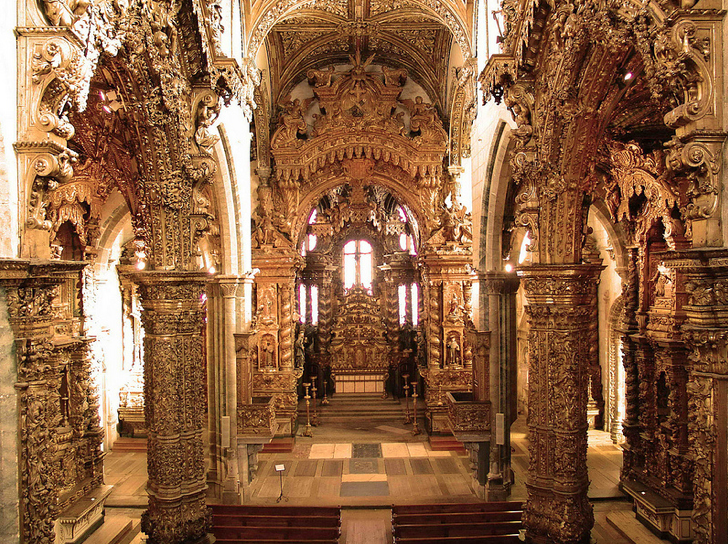
Nearly every inch of the interior – walls, pillars, side chapels, window frames and the ceiling – is covered in elaborately detailed Portuguese gilt woodwork. It’s done in the Baroque style, highly decorative with images of leaves, floral motifs, fruits, animals, and cherubs, all of them bathed in a rich bath of gold leaf. It is estimated to have taken 400 kilograms of gold (more than any other church in the world!) to complete the gilt work in the Igreja de Sao Francisco and is considered the most beautiful gilt work in Portugal, and some would say in all of Europe.
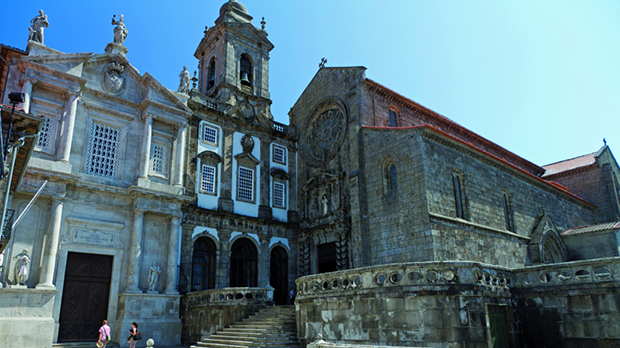
Igreja de Sao Francisco exterior
This hidden gem serves as a metaphor for the city of Porto itself. Where Lisbon and the Algarve region of Portugal attract most of the attention from tourists, Porto remains inconspicuous. But one walk through its historic streets and you quickly realize there’s nothing subtle or boring about this place. Just like the gold embellished church of Sao Francisco, Porto’s offerings are bold, artistic, stylish and unforgettable.
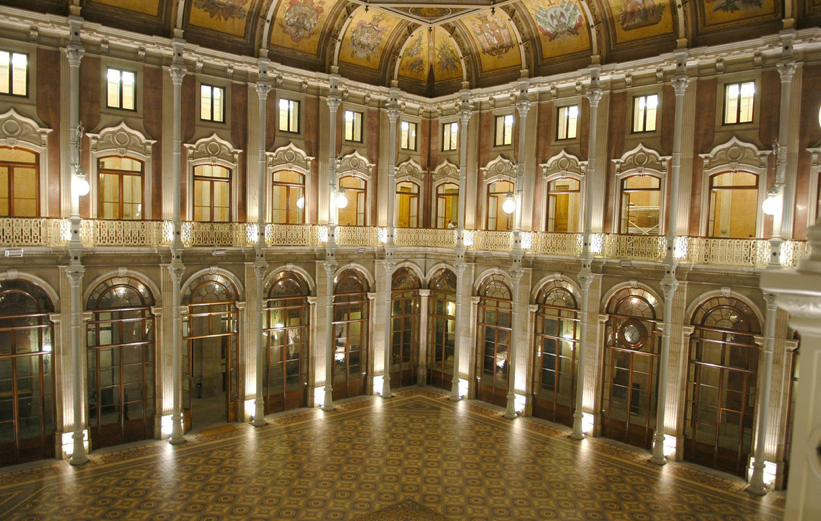
Palacio da Bolsa
Although the Igreja de Sao Francisco is the prettiest building in town, Porto is teeming with beautiful architecture worth exploring. Right next door to the Sao Francisco is the Palacio da Bolsa, the city’s former stock exchange. The 19th century building’s façade has the stately, yet simple elegance of Neoclassical design, but – just like the Sao Francisco – there’s nothing subtle about the interior of this building. Moorish style dominates indoors, with colourful stuccowork embellished with precious stones, colourful stained glass, elegant marble, and more gilded wood covered with 40 pounds of gold leaf. A bit further up town, the Igreja de Carmo and the Igreja de Carmelitas – two conjoined churches that look like one building from the outside – are additional examples of stunning late Baroque style architecture, featuring a richly detailed stone exterior, an elegant gilded wood interior, and a massive blue and white tiled azulejo panel on one side of the structure.

Palacio da Bolsa
The Portuguese took inspiration from the Arabs when developing the azulejo style of tin-glazed ceramic tile art. These, sometimes colourful and sometimes highly detailed, tiles can be seen decorating interior and exterior walls, floors and even ceilings of buildings across Porto and the rest of Portugal.
The most notable azulejo tile work can be found at the Sao Bento train station. Completed in 1916, the main atrium of the station is covered with panels consisting of 20,000 tiles designed by renowned azulejo artist Jorge Colaço. The tile art depicts landscapes and historical events taking visitors through the history of Porto from the 1100s till present day.
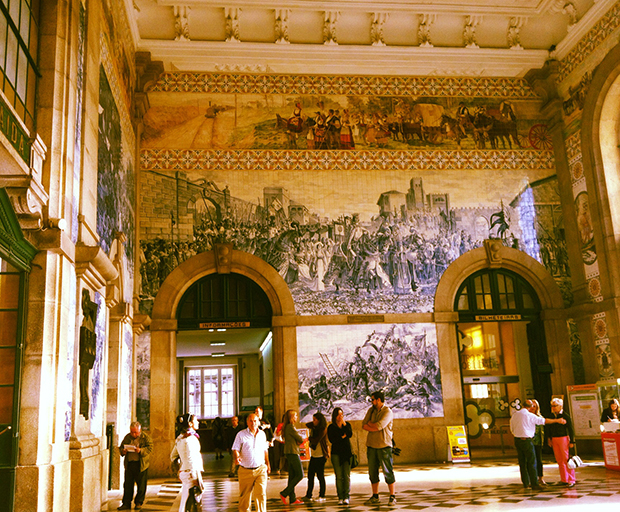
Sao Bento train station
A quick, five-minute walk will bring you to the Livraria Lello & Irmão, what’s considered one of the most beautiful bookstores in the world. And it’s easy to see why. The lacy look of the part Art Nouveau, part Gothic revival façade makes the store front pop out from among its neighbouring buildings. Although the inside of the two-story shop is fairly tiny, it packs a real punch. The wooden floor-to-ceiling bookcases are intricately carved and arch beautiful at the top, the pillars are decorated with bronze bas-reliefs of Portuguese literati and a lovely stained-glass skylight naturally illuminates the store. The focal centerpiece of the room is a stunning red, curvaceous Art Nouveau staircase.
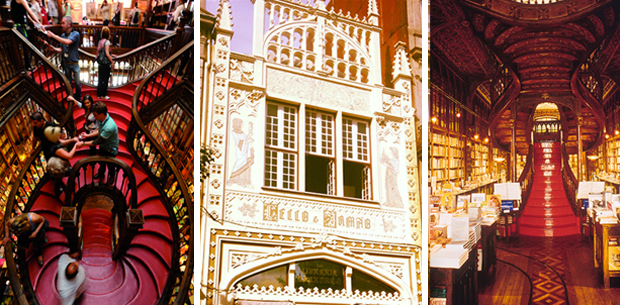
Livraria Lello & Irmão
The bookstore inspired J.K. Rowling’s vision for Harry Potter’s library in Hogwarts. Rowling lived in Porto in the early 1990s and spent much of her time at the Majestic Café working on the first book in the Harry Potter series.
With its striking marble-sculpted façade, the Majestic Café is everything its name suggests. Again, Art Nouveau is the predominant style here with curved lines breaking up the symmetrical and rectangular layout of the room, its window and its doorways. Large mirrors cover the wall making the room look big and spacious and a number of lamps, chandeliers and sconces bathe the space in a warm, golden light.

Majestic Café
Further down towards the water, the Ribiera is definitely the most picturesque part of the city. The entire neighbourhood has been designated a UNESCO World Heritage Site, and you’ll quickly learn why. You can spend hours exploring its steep, cobblestoned streets taking in the candy-coloured exteriors of the ancient homes, or strolling next to the river Douro. This is also a great place to enjoy a traditional seafood lunch at one of the many waterfront restaurants, or a relaxing river cruise in an old-fashioned “Rabelo” boat.
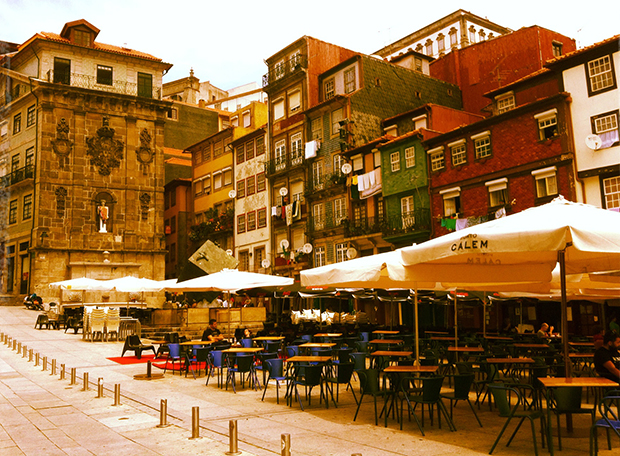
Ribiera
It’s also from here that you get one of the best views of the Ponte de Dom Luis, the metal arch bridge built by the colleague of Gustave Eiffel, the man that built the Eiffel Tower in Paris. A quick walk across will bring you to the municipality of Vila Nova de Gaia, the best place for a great panoramic view of the colourful, terracotta-roofed buildings of Porto, and the rabelo boat dotted river Douro.
This side of the bridge is also the place to find a perfect glass of port wine and bit of a story behind how it got to your glass. The beautiful waterside promenade is home to about 60 port wine lodges and cellars, many of which offer wine tastings and tours.
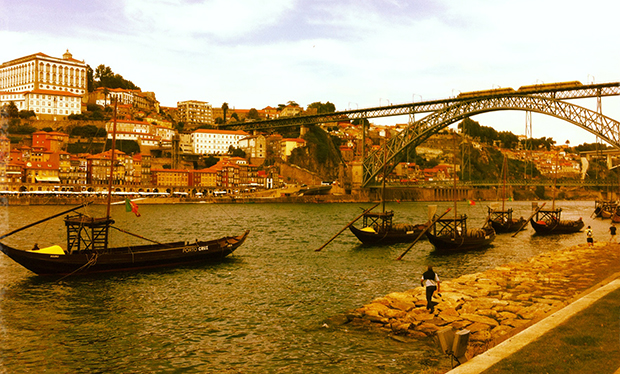
View of Porto from Vila Nova de Gaia
Sunny days, year-round pleasant temperatures and its compact size make Porto a great walking city. And there are many pedestrian friendly streets in the city waiting to be explored.
Aliados avenue is a good place to start your exploration on foot. Easily accessible from Metro stations Aliados or Trindade, the Avenida dos Aliados is the monumental heart of Porto. A promenade runs down the centre of the road and stunning architecture – mainly hotels and banks – lines both sides of the street. On one end of the street is Town Hall, an impressive granite and marble structure complete with a 70-metre tall bell tower. On the other end of the street is the Praça da Liberdade, a city square with a centerpiece statue of King Pedro IV on a horse.
Explore Miguel Bombarda street, José Falcão street, and Cândido dos Reis street to get a feel of the contemporary arts scene in Porto. You’ll find at least a dozen art galleries in this area that show regular exhibits every month, as well as restaurants, bookstores and several furniture, décor and design shops. Tea connoisseurs should definitely pop into Rota do Chá on Miguel Bombarda street for a sip of specialty teas from around the world. For the fashionistas there is the King Kong shop, an urban explosion of trendy clothing, footwear, bags, accessories presented in a quirky and modern atmosphere.

Feeling the dinner time grumblings? Make your way to Chef Rui Paula’s DOP Restaurant. Located inside the Palácio das Artes – a distinctive fourteenth century building – Chef Paula’s menu comprises of classic Portuguese dishes fused with international influence, where each plate is executed with an unmistakable modern presentation.
At night, the most perfect place to rest your head is the Hotel Infante Sagres. Built in the 1950s, the building of the hotel looks like a 19th century Portuguese mansion. Ornate Baroque furnishings fuse together with modern custom-made furniture and contemporary artwork to create an air of luxury that appeals to every taste. Stained glass windows and crystal chandeliers sparkle throughout the common areas. Breakfast is served each morning in a grand hall that resembles a royal tea room.
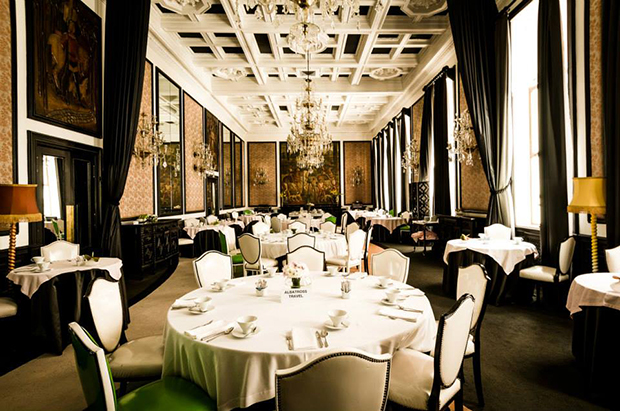
It’s no surprise that celebrities (Bob Dylan, Catherine Deneuve, John Malkovich) and royalty (the Dalai Lama, the King of Norway, the Queen of The Netherlands, Prince Edward of England) have chosen to stay at the Hotel Infante Sagres. The hotel’s luxury amenities, stylish décor and prime location make it the ideal place to rest after a day of exploring Porto’s medieval relics, extravagant baroque churches and narrow, winding streets full of artful treasures.
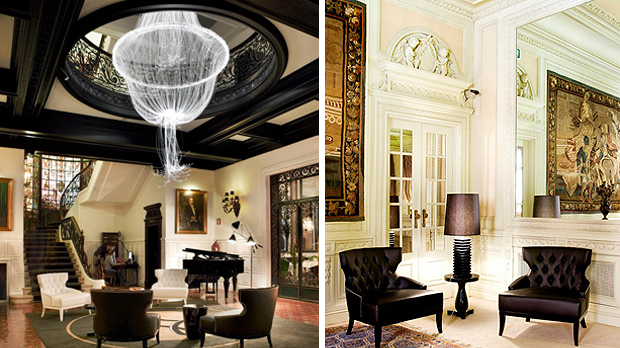
Obrigado Porto. If all my memories of Portugal were a set of photos, you’ve made the entire collection worthy of an art showing.
Leave a Reply